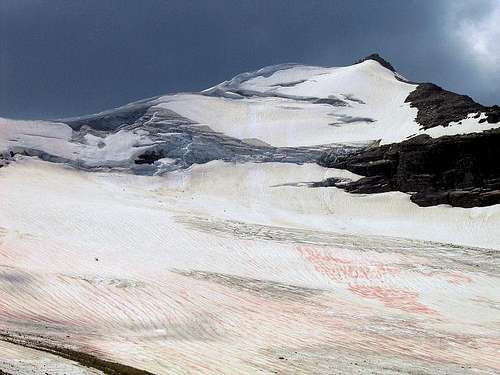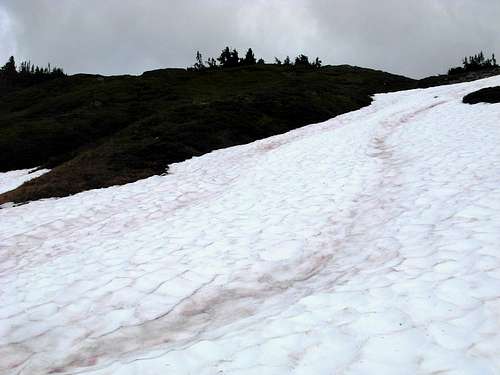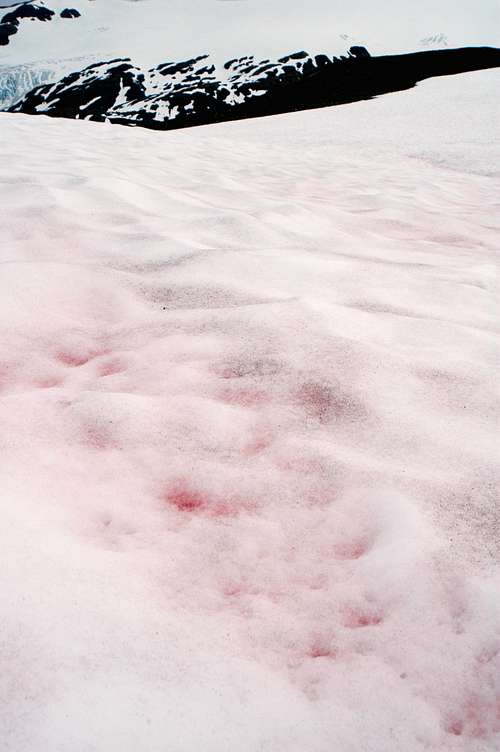Is It Snow, Blood, Or Something Else?
Have you ever been in the backcountry and noticed streams or pockets of reddish-pink snow? Have you ever wondered what causes the phenomenon? Have you ever noticed that walking through the red snow can stain your boots and pants? Have you ever wondered if the red snow is edible? If you answered "yes" to any of those questions, then this article might be suited for you.
For thousands of years, reddish-colored snow has fascinated many people. Although the phenomenon has been referenced many times through the years, its reddish-pink coloration and occasional watermelon-like scent has led to the widely recognized nickname of
watermelon snow. Explorers, mountaineers, and skiers have identified watermelon snow for many years, yet until the late 19th Century the cause of the phenomenon remained a mystery.
![Watermelon Snow]() Watermelon Snow
Watermelon Snow
Ancient Greek philosopher Aristotle provided the first-known written accounts of watermelon snow, although no explanation of the phenomenon was given. Centuries later, many Europeans speculated that the reddish color was geological in nature, either being caused by mineral deposits on the snow or chemicals leaching from rocks. However, it would not be until 1818 before the most breakthrough accounts of watermelon snow would finally occur.
During May of that year, four English ships, led by Captain John Ross, were sent to the Arctic Circle on a quest to find a "Northwest Passage" to the Pacific Ocean as well as chart the northern coast of North America. While traveling through the Arctic Circlt, severe weather conditions forced the expedition to end prematurely and the vessels returned back towards England. While passing back by the northwest coast of Greenland, Captain Ross noted many blood-like red streams coming down snowy slopes. He had several crewmembers bring back samples of the red snow with them to England. Of course, by the time the samples reached England, the snow had long-since melted. Fortunately, the leftover colored liquid was still usable to scientists.
Upon arriving back in England, the liquified watermelon snow samples were immediately studied by scientists. The liquid had such a dark red color that it resembled a red wine. The strange coloration of the liquid coupled with Captain Ross' accounts of the red snow streams caused much confusion and speculation. Some scientists even asked Captain Ross if he had seen red snow falling from the sky, which he had not. The British newspaper
The Times published an article about the discovery on December 4, 1818. The article did not provide any immediate explanation for the cause of the phenomenon. However, a follow-up article was written three days later that erroneously speculated the reddish color on the snow was caused by meteor deposits, and that the samples retrieved by Captain Ross and his crew were actually iron specimens mixed with snow.
Captain Ross published a full account of his expedition by the end of 1818, and within the documentation he included a botanical appendix written by famed Scottish botanist Robert Brown. In that appendix, Brown speculated the reddish-colored snow was caused by a type of algae. It would not be until the late 1800s before scientists would correctly determine that watermelon snow was actually caused by high concentrations of microscopic algae, known as snow algae, but it was Brown's assessment that provided the foundation for the scientific discovery.
What Is Snow Algae?
Snow algae is also known by the scientific name
Chlamydomonas nivalis. Contrary to its appearance, snow algae is actually a type of freshwater green algae. In scientific terms, the genus name
Chlamydomonas refers to green algae, and the species name
nivalis is a Latin word that refers to snow.
As is true with all species of green algae, the primary pigment of snow algae is green (chlorophyll). However, snow algae also has a secondary pigment that is red. This red carotenoid pigment protects the algae from intense radiation, both visible and ultraviolet. The red pigment also absorbs heat for the algae.
Unlike most freshwater green algae, snow algae thrives in a cold environment. During Winter months, the algae becomes dormant as snowpack covers over them. Then, during Spring and Summer months, increasing amounts of light, snowmelt, and nutrients triggers the germination process of the snow algae to begin. In addition, the red carotenoid pigment of snow algae, by virtue of absorbing heat, causes snow to melt faster than normal around the algae. The algal germination process can then occur rapidly, causing a sudden high concentration, or
bloom, of snow algae.
![Sperry Glacier]() Blooms Of Snow Algae On Gunsight Mountain, Montana (Photo by SummitPost member "saintgrizzly")
Blooms Of Snow Algae On Gunsight Mountain, Montana (Photo by SummitPost member "saintgrizzly")
This algal bloom is then represented by streams, patches, or small pocket-holes (known as sun-cups) of reddish-pink coloration as the algae rises to the surface of the snow. Then, as the nutrients of the immediate area are depleted, the snow algae create thick-walled cells that will remain dormant until the following Spring and Summer months when the cycle will begin again.
![Streams Of Watermelon Snow]() Streams Of Watermelon Snow In North Cascades
Streams Of Watermelon Snow In North Cascades
Snow algae is commonly found worldwide in alpine and coastal polar areas. In western North America alone, there are over 60 sub-species of
Chlamydomonas nivalis. In some locations, such as over 10,000' elevation in the Sierra Nevada range of California, blooms of snow algae have even been known to be so vast that they can be 10" deep in snow. One teaspoon from an algal bloom might contain as much as one million cells of snow algae, with each cell being 25-30 micrometers in diameter.
![Looking down at the top of...]() Snow Algae On Mount Timpanogos, Utah (Photo by SummitPost member "EJBean")
Snow Algae On Mount Timpanogos, Utah (Photo by SummitPost member "EJBean")Is Watermelon Snow As Edible As An Actual Watermelon?
Although
watermelon snow is a nickname of snow algae, it begs the question: Is watermelon snow actually edible?
In general, most algae is considered edible. Even the faint watermelon-like scent of snow algae might give that impression. The author of this SummitPost article has even tasted very small doses of snow algae, for testing purposes, without feeling sick. However, it is possible that snow algae might be contaminated by bacteria and toxic algae that are harmful to humans. Eating large quantities of watermelon snow has been known to cause digestive ailments, although the tolerance level of each person's digestive system might be different.
Although human consumption of watermelon snow is not wholely recommended, many organisms consider the algae as a delicacy and, for some, an essential food source. Most notably, ice worms, roundworms, snow fleas, and protozoans regularly consume snow algae. At high elevations, it is common to see millions of ice worms atop snowfields during early morning and late evening hours, especially near snow algae blooms.
![Pink Snow where Ice Worms grow]() Watermelon Snow In Alaska (Photo by SummitPost member "jmc")
Watermelon Snow In Alaska (Photo by SummitPost member "jmc")External Links
For more information and accounts about watermelon snow, please feel free to visit the following links:
National Geographic's Article Examining Snow Algae
Australian Anarctic Division's Article Examining Snow Algae
Watermelon Snow: A Strange Phenomenon Caused by Algal Cells Of The Chlorophyta
Are There Other "Exploring The Mystery Of" Articles?
If you enjoyed reading this article, and/or found it interesting, perhaps you might also like to read the other articles in my "Exploring The Mystery Of" series:
Exploring The Mystery Of Summit Ladybugs
Exploring the Mystery Of Glacier Ice Worms











Comments
Post a Comment